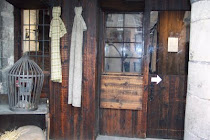

This is an ell stick. An ell was a Scots measurement of 37" (94cms). It was generally assumed that this was the length of the average person's arm. It may interest you to know that for the Flemish it was 27", the Polish 31" the Danish 25" and the English 45" (that's the measurement, not the arm!). The measurement was standardised in 1661 but continued to be used locally in Scotland during the 18th Century and was replaced with the English system by Act of Parliament in 1824.
Back to my Edinburgh housewife - If a Cloth Merchant or Tailor got a reputation for giving a short measure to his customer (the upstanding Edinburgh housewife), he was duly removed from his establishment and taken to the Tolbooth (which served as the Council House, Courtroom and Prison) whereupon - if found guilty - he was nailed to the door by the ears and left overnight (obviously to consider his crime!)
When he was removed from the door, did they gently remove the nails? No, they did not! He was pulled bodily from the door and sent on his way with some sterm words. Thereafter, anyone having occasion to visit his establishment in the future would know what he'd been up to by the state of his ragged ears and would probably avoid him and his business like the plague. It was therefore in his own interest to be an honest trader.
Back to my Edinburgh housewife - If a Cloth Merchant or Tailor got a reputation for giving a short measure to his customer (the upstanding Edinburgh housewife), he was duly removed from his establishment and taken to the Tolbooth (which served as the Council House, Courtroom and Prison) whereupon - if found guilty - he was nailed to the door by the ears and left overnight (obviously to consider his crime!)
When he was removed from the door, did they gently remove the nails? No, they did not! He was pulled bodily from the door and sent on his way with some sterm words. Thereafter, anyone having occasion to visit his establishment in the future would know what he'd been up to by the state of his ragged ears and would probably avoid him and his business like the plague. It was therefore in his own interest to be an honest trader.


















Dios mio, que condena mas mala!!!!
ReplyDeleteQue dolor de orejas jejejejeje
Me ha encantado tu explicacion
besitos ascension
WOW!! I bet not many of them cheated!
ReplyDeleteOuch!! I remember reading a story of a 16th century man who asked a lace dealer how much a length of lace from ear to ear would cost - on being quoted a modest sum he ordered a mile of lace as his 'other ear' was in the town square!
ReplyDeleteThe medieval laws about the sale of woollen cloth are fascinating, too.
As always, your presentaion is superb, Irene!!
Ouch...what an interesting piece of history.
ReplyDeleteThe table looks great.
Gracias por compartir esa historia... me encantan esas curisidades... y que condena mas curiosa colgado de las orejas¡¡¡ se lo pensaria mas de uno engañar a los clientes¡¡¡ Saludos
ReplyDeleteA very interesting and terrible story and tradition. I love reading about customs and traditions.
ReplyDeleteI love your last photo. The fabric is great.
Geneviève
Thank you everyone. All these stories fascinate me too. I'm trying to collect more and I'll pass on what's relevent to my Tenement.
ReplyDeleteHi Irene,
ReplyDeleteI daresay any cloth merchant with strong ears wearing 2 plank earrings would also be avoided.
V
Love love love these stories, fables and history. Please keep them coming!
ReplyDeleteFascinating story, Irene, as usual. I'm wincing, of course, but can imagine modelling a crooked cloth merchant with a ripped ear for rigorous historical accuracy ... :)
ReplyDeleteOooh, what horrible punishments people thought up in those days, it makes me shudder. Rather interesting though. I visited Edinburgh in my twenties and loved it, the little squirrels in the park near the castle.
ReplyDeleteI love your house and your choice of furnishings.